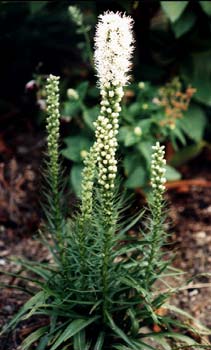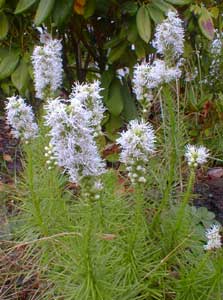
Liatris spicata 'Floristan White'
White Spike Gayfeather; aka,
Dense Blazing Stars; aka,
Sessile Blazing-star; aka,
Button Snakeroot; aka,
Snake Button; aka
Colic-root; aka,
Devil's Bite
The perennial Liatris spicata 'Floristan White' is strongly drought-tolerant. We obtained two very small starts in tiny pots & put them out on the roadside in a sun-garden.
Many types of plants that are drought tolerant once established have quite a lot of trouble at first if not regularly watered & tended until they're older plants, but these Spike Gayfeathers right from day one never required any attention. One of them is shown above in September of its first year in the ground (2002), blooming late because it spent the whole summer maturing from a tiny start. The second photo is from August (2004).
Gayfeather is native of eastern North America from Canada to Florida. They ordinarily bloom June through August, but ours bloom July through all of September, sometimes lingering into early October. My suspicion is if they were watered a bit in summer, they would bloom starting June as they're supposed to, but they're doing more than good enough in their neglected spot.
 For 'Floristan White' the flower spikes reach no higher than three feet tall, often smaller. Ours in this neglected spot don't quite reach two feet. This is about half the size of purple cultivars, & the wild species is bigger still, with flower spikes as tall as six feet.
For 'Floristan White' the flower spikes reach no higher than three feet tall, often smaller. Ours in this neglected spot don't quite reach two feet. This is about half the size of purple cultivars, & the wild species is bigger still, with flower spikes as tall as six feet.The fluffy flower spikes are favorites of butterflies & bees. The blooms are long-lasting whether in the garden or as cut flowers. The spikes bloom starting at the top & working their way to the bottom, & if cut for bouquets when only blooming near the top, the spikes' buds will open day by day, & the spent top can be trimmed as it fades. This means they're exceptionally long-lasting in flower arrangements.
They can also be dried for winter use in arrangements. They should be cut when half to two-thirds in bloom, then hung upside down in a dark, warm, dry room with good air-circulation. An arrangement of dried Liatris & Yarrow from the garden will bring a bright remembrance of summer for a winter's table.
When the flowers are dried & spent, they still have a browned decorative value for a little while in Autumn, but by November they look dead. The blackened dried flower spikes may persist unattractively in winter & it's up to individual tastes whether to prune them right away or wait until spring. Small birds such as finches will cling to the spikes in late autumn or early winter to eat the feathery seeds, but eventually the plant is very homely in winter, so we don't leave the stalks standing.
The plant reemerges as a circular clump of bright turf in spring. The largest grassy leaves are at the bottom of the whorl of turf, & the leaves get progressively smaller as the mound rises. It's quite elegant even before developing the tall spike of florets.
The plant has a susceptibility to powdery mildew if too crowded or in shade, so plenty of sunlight & good air circulation all around it is essential. Ours never showed any such affliction. They will thrive in heat, cold, & dryness, but are occasionally harmed by too much moisture during the winter. Though L. spicata especially in spring & summer is more tolerant of dampness than other species of Liatris, & is even occasionally called "Marsh Gayfeather," it is still possible the rootstock could rot in winter from too much rainfall. Perfectly draining soil is therefore a must, & planting on a small raised area anc help in that regard. They prefer full sun morning & afternoon.
Spike Gayfeather grows from tuberous rootstock. The rootstock can be dug up every three or four years & divided, preferrably in early spring. Ours has developed more slowly than clumps that are more tended, & will probably not be divided until their fifth year. It can also be propogated from seed, but needs very warm spring temperatures to germinate properly & may need to be started indoors in pots to be warm enough. When seed-grown, it takes two years to mature enough to bloom.
Because the tuber is of an unusual shape that appears to have a bite out of it, this & other species of Liatris are sometimes called "The Devil's Bite." This magical-appearing root has long given it an association with cthonic healing powers. Names like "Button Snakeroot" (or like L. squarrosa's unusual common name "Rattlesnake Master") derive from the Native American use of Liatris species to treat poisonous snakebites.
So too the name "Colic Root" associates species of Gayfeather with medicinal properties. It has been used for treating dropsy, ulcers, or diarrhea. Although actual efficacy in the majority of its alleged values is doubtful, the root's bitter chemical component Coumarin may well have some benifits beyond its conclusive value as a diuretic.
There are many natural wild variant races of Dense Gayfeather, which has assisted growers in producing excellent select cultivars. Besides the White Spike gayfeather, there is also Purple Spike. The most commonly available semi-dwarf cultivar is a purple variety called 'Kobold' which does not get so tall as 'Floristan White.' 'August Glory' is violet & grows much taller than the white. Many other cultivars exist in shades of blue, purple, white, & magenta, but not all are widely available.
There are also other species of Liatris such as Meadow Blazing Star (L. ligulistylis), Dwarf Gayfeather (L. microcephala), & others, most of which tend not to be quite so apt to forgive our wet winters, but I'd be tempted to give any of them a try & hope for the best.